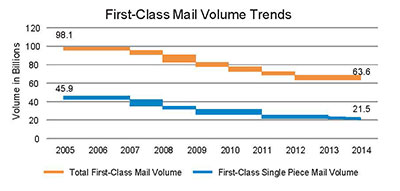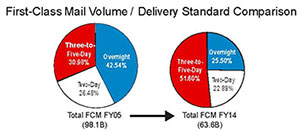USPS Delivery Standards and Statistics fact sheet
In 2014, the Postal Service delivered 155.4 billion pieces of mail and packages. For each product, the Postal Service sets standards pertaining to mail delivery so that customers and mailers can expect consistent and predictive delivery.
In 2011, based on dramatically declining mail volumes and the subsequent excess capacity in its mail processing network, the Postal Service announced consolidation of its processing and distribution facilities and revisions to its First-Class Mail service standards¹.

In the past 10 years, total volume has declined by more than 56 billion pieces (or 26%), First-Class
Mail volume has declined 34.5 billion pieces (or 35%), and single-piece First-Class Mail (primarily letters bearing postage stamps) has declined 24.4 billion pieces (or more than 50%).
In January 2015, the Postal Service changed its First-Class Mail service standards, affecting roughly 14 billion pieces of the total volume (or 9%) and up to 16% of First-Class Mail. The affected volume represents primarily single-piece First-Class Mail. The majority of this mail is being delivered in two days instead of one.
Major mailers presenting First-Class Mail to the Postal Service will continue to have an opportunity to present their mail for overnight processing and delivery based on revised entry times.
Today, total First-Class Mail is delivered in an average of 2.1 days. Prior to the service standard change, First-Class Mail was delivered in an average of 1.8 days.

In the past 10 years, major industries such as utility, telecommunications and credit companies made the decision to move away from overnight mail on their own by consolidating their mailing operations. Only 11 percent of Commercial First-Class Mail is overnight mail.
|
The following will NOT be affected by the service standards change:
|
More than 80% of consumers say that adding one delivery day to local and national mail would have “no effect” or it would be a “change (they) could easily adapt to,” according to a study conducted by HSR Associates in June 2014.² |
The Postal Service is continually working to improve efficiencies by making better use of space, staffing, equipment and transportation to process the nation’s mail. Improving efficiencies has become increasingly important, given the significant reduction in the amount of First-Class Mail that enters the postal system.
For additional information, go to usps.com/ourfuturenetwork.
¹ A service standard is the stated delivery performance goal for a mail class or product. Taking into account network logistics and feasibility, a service standard reflects the number of days after acceptance of a mail piece by which the sender and recipient can expect it to be delivered.
² HSR Associates sample size of 1,093, representative of the U.S. households based on demographics.
Posted 3/23/15
